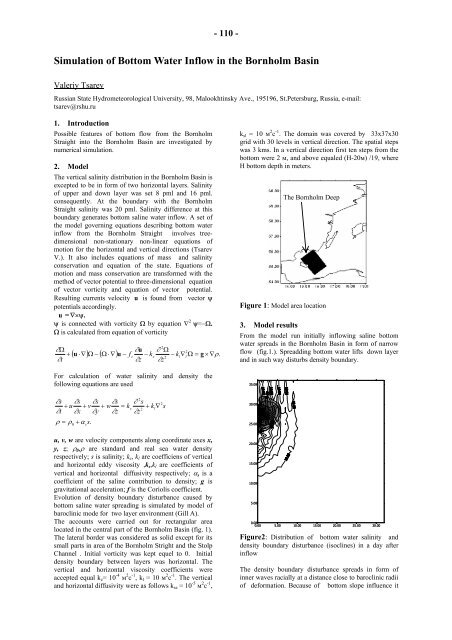Fourth Study Conference on BALTEX Scala Cinema Gudhjem
Fourth Study Conference on BALTEX Scala Cinema Gudhjem
Fourth Study Conference on BALTEX Scala Cinema Gudhjem
You also want an ePaper? Increase the reach of your titles
YUMPU automatically turns print PDFs into web optimized ePapers that Google loves.
- 110 -<br />
Simulati<strong>on</strong> of Bottom Water Inflow in the Bornholm Basin<br />
Valeriy Tsarev<br />
Russian State Hydrometeorological University, 98, Malookhtinsky Ave., 195196, St.Petersburg, Russia, e-mail:<br />
tsarev@rshu.ru<br />
1. Introducti<strong>on</strong><br />
Possible features of bottom flow from the Bornholm<br />
Straight into the Bornholm Basin are investigated by<br />
numerical simulati<strong>on</strong>.<br />
2. Model<br />
The vertical salinity distributi<strong>on</strong> in the Bornholm Basin is<br />
excepted to be in form of two horiz<strong>on</strong>tal layers. Salinity<br />
of upper and down layer was set 8 pml and 16 pml.<br />
c<strong>on</strong>sequently. At the boundary with the Bornholm<br />
Straight salinity was 20 pml. Salinity difference at this<br />
boundary generates bottom saline water inflow. A set of<br />
the model governing equati<strong>on</strong>s describing bottom water<br />
inflow from the Bornholm Straight involves treedimensi<strong>on</strong>al<br />
n<strong>on</strong>-stati<strong>on</strong>ary n<strong>on</strong>-linear equati<strong>on</strong>s of<br />
moti<strong>on</strong> for the horiz<strong>on</strong>tal and vertical directi<strong>on</strong>s (Tsarev<br />
V.). It also includes equati<strong>on</strong>s of mass and salinity<br />
c<strong>on</strong>servati<strong>on</strong> and equati<strong>on</strong> of the state. Equati<strong>on</strong>s of<br />
moti<strong>on</strong> and mass c<strong>on</strong>servati<strong>on</strong> are transformed with the<br />
method of vector potential to three-dimensi<strong>on</strong>al equati<strong>on</strong><br />
of vector vorticity and equati<strong>on</strong> of vector potential.<br />
Resulting currents velocity u is found from vector ψ<br />
potentials accordingly.<br />
u = ∇×ψ.<br />
ψ is c<strong>on</strong>nected with vorticity Ω by equati<strong>on</strong> ∇ 2 ψ=−Ω.<br />
Ω is calculated from equati<strong>on</strong> of vorticity<br />
2<br />
∂Ω<br />
∂u<br />
∂ Ω<br />
+ u z<br />
z 2 l l<br />
∂t<br />
∂z<br />
∂z<br />
2<br />
( ⋅∇)<br />
Ω − ( Ω ⋅ ∇)<br />
u − f − k − k ∇ Ω = g × ∇ρ.<br />
For calculati<strong>on</strong> of water salinity and density the<br />
following equati<strong>on</strong>s are used<br />
2<br />
∂s<br />
∂s<br />
∂s<br />
∂s<br />
∂ s 2<br />
+ u + v + w = kz<br />
+ kl∇<br />
s<br />
2<br />
∂t<br />
∂x<br />
∂y<br />
∂z<br />
∂z<br />
ρ = ρ + α s.<br />
0<br />
s<br />
u, v, w are velocity comp<strong>on</strong>ents al<strong>on</strong>g coordinate axes x,<br />
y, z; ρ 0,ρ are standard and real sea water density<br />
respectively; s is salinity; k z, k l are coefficiens of vertical<br />
and horiz<strong>on</strong>tal eddy viscosity ,k s,k l are coefficients of<br />
vertical and horiz<strong>on</strong>tal diffusivity respectively; α s is a<br />
coefficient of the saline c<strong>on</strong>tributi<strong>on</strong> to density; g is<br />
gravitati<strong>on</strong>al accelerati<strong>on</strong>; f is the Coriolis coefficient.<br />
Evoluti<strong>on</strong> of density boundary disturbance caused by<br />
bottom saline water spreading is simulated by model of<br />
baroclinic mode for two layer envir<strong>on</strong>ment (Gill A).<br />
The accounts were carried out for rectangular area<br />
located in the central part of the Bornholm Basin (fig. 1).<br />
The lateral border was c<strong>on</strong>sidered as solid except for its<br />
small parts in area of the Bornholm Stright and the Stolp<br />
Channel . Initial vorticity was kept equel to 0. Initial<br />
density boundary between layers was horiz<strong>on</strong>tal. The<br />
vertical and horiz<strong>on</strong>tal viscosity coefficients were<br />
accepted equal k z= 10 -4 м 2 с -1 , k l = 10 м 2 с -1 . The vertical<br />
and horiz<strong>on</strong>tal diffusivity were as follows k sz = 10 -5 м 2 с -1 ,<br />
ksl = 10 м 2 с -1 . The domain was covered by 33х37x30<br />
grid with 30 levels in vertical directi<strong>on</strong>. The spatial steps<br />
was 3 kms. In a vertical directi<strong>on</strong> first ten steps from the<br />
bottom were 2 м, and above equaled (Н-20м) /19, where<br />
Н bottom depth in meters.<br />
Figure 1: Model area locati<strong>on</strong><br />
3. Model results<br />
The Bornholm Deep<br />
From the model run initially inflowing saline bottom<br />
water spreads in the Bornholm Basin in form of narrow<br />
flow (fig.1.). Spreadding bottom water lifts down layer<br />
and in such way disturbs density boundary.<br />
35.00<br />
30.00<br />
25.00<br />
20.00<br />
15.00<br />
10.00<br />
5.00<br />
0.00<br />
0.00 5.00 10.00 15.00 20.00 25.00 30.00<br />
Figure2: Distributi<strong>on</strong> of bottom water salinity and<br />
density boundary disturbance (isoclines) in a day after<br />
inflow<br />
The density boundary disturbance spreads in form of<br />
inner waves racially at a distance close to baroclinic radii<br />
of deformati<strong>on</strong>. Because of bottom slope influence it













